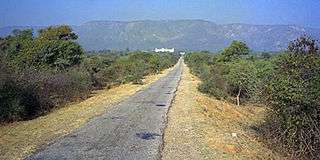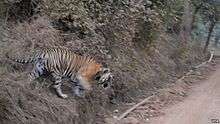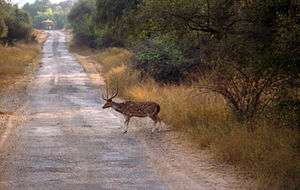Sariska Tiger Reserve
| Sariska | |
|---|---|
| Sariska Tiger Reserve | |
|
IUCN category II (national park) | |
|
A deer in Sariska Reserve | |
 | |
| Location | Alwar District, Rajasthan, India |
| Nearest city | Alwar |
| Coordinates | 27°19′3″N 76°26′13″E / 27.31750°N 76.43694°ECoordinates: 27°19′3″N 76°26′13″E / 27.31750°N 76.43694°E |
| Area | 866 km2 (334 sq mi) |
| Established | 1955 |
| Governing body | Project Tiger, Government of Rajasthan, Wildlife Warden, Sariska National Park |
|
www | |
Sariska Tiger Reserve is a national park and tiger reserve located in the Alwar district of the state of Rajasthan, India. The topography of the protected area comprises scrub-thorn arid forests, rocky landscapes, dry deciduous forests, rocks, grasses and hilly cliffs. This area was a hunting preserve of the Alwar state and it was declared a wildlife reserve in 1955. It was given the status of a tiger reserve making it a part of India's Project Tiger in 1978. The wildlife sanctuary covers an area of 866 km2 (334 sq mi). The reserve was declared a national park in 1982, with a total area of about 273.8 km2 (105.7 sq mi).[1] It is the first reserve in the world to have successfully relocated tigers.
The park is situated 106 km (66 mi) away from Hindaun, 107 km (66 mi) from Jaipur and 200 km (120 mi) from Delhi.[2] It is a part of the Aravalli Range and the Kathiawar-Gir dry deciduous forests' ecoregion.[3] It is rich in mineral resources, such as copper. In spite of the Supreme Court's 1991 ban on mining in the airarea, marble mining continues to threaten the environment.[4]
Tiger population
In 2004, there were strong and persistent reports that no Bengal tigers were being sighted in the reserve. It was not only that tigers were not being seen but also and more alarmingly, there was no indirect evidence of the tigers' presence (such as pugmarks, scratch marks on trees, etc.). The Rajasthan Forest Department took the stand that "the tigers had temporarily migrated outside the reserve and would be back after monsoon season". Project Tiger, now National Tiger Conservation Authority (NTCA), backed this assumption. There were 16 tigers in the previous year. In January 2005, journalist Jay Mazoomdaar broke the news[5] that there were no tigers left in Sariska. Soon the Rajasthan Forest Department and the Project Tiger Director declared an "emergency tiger census" in Sariska and the Central Bureau of Investigation, India's intelligence agency, conducted a probe. After a two-month investigation they finally declared that Sariska did not have any tigers left. Poaching was blamed for the disappearance of tigers. In order to repopulate Sariska with tigers, three tigers were relocated to the reserve and authorities planned to relocate two more tigers by the end of the following year. Recently, two tiger cubs and their mother were spotted in the reserve bringing the total number of tigers to seven with five adults.[6] In July 2014, 2 more tiger cubs were spotted taking the total of tigers in the reserve to 11 with 9 adults.[7] Two cubs were further sighted in August 2014, making the total of tigers in Sariska to 13, with 7 females, 2 males and 4 cubs. This significant increase in tigers' population has been welcomed by wildlife enthusiasts and therefore the footfall has been increased by a huge amount.
Relocation efforts

In 2005, the Government of Rajasthan, in cooperation with the Government of India and Wildlife Institute of India (WII), planned the re-introduction of tigers to Sariska and also the relocation of villages.[8] Plans to construct a bypass were also discussed.[9] It was decided to import one male and two females from Ranthambore National Park.[10] The Wildlife Institute of India (WII) along with the Government of Rajasthan started tracking the relocated tigers with the help of ISRO's reconnaissance satellites.[11] The first aerial translocation of the male tiger (Dara) from Ranthambhore to Sariska was done on 28 June 2008 by Wing Commander Vimal Raj of the Indian Air Force using a Mi-17 Helicopter.[12]
Only two of the four villages' experts had said needed to be relocated were actually moved, though the second, Kankwari,[13] was shifted long after the tigers were re-introduced. However, Kankwari fort has been renovated by the state tourism department, which can possibly violate wildlife protection norms.[14] The first relocated village was Bhagani. Also, the diversion of roads crossing the reserve, an issue critical to the survival of its wildlife, continues to be a problem.[15]

One more tigress was shifted to Sariska from Ranthambhore in February 2009.[16] On 28 July 2010, another tigress was brought from Ranthambhore National Park. Totaling five tigers — two males and three females — were living in the reserve until November 2010 when the first relocated tiger died[17] due to poisoning.[18]
Unfortunately, the first three of the relocated tigers came from one father. Moreover, the first two tigresses have the same mother.[19][20] The breeding of close relatives leads to inbreeding.
General information

- Area: 866 km2
- Altitude: between 300 m and 722 m MSL
- Rainfall: average 650 mm (per year)
- Forest types: tropical, dry, deciduous, and tropical thorn
Flora and fauna
Apart from the Bengal tiger, the reserve includes many species of wild life, such as the Indian leopard, jungle cat, caracal, striped hyena, Indian jackal, chital, sambhar, nilgai, chinkara, four-horned antelope,[21] wild boar, hare, hanuman langur, rhesus monkeys. Sasrika is also ethereal for bird watchers with some of the rarest feathered species like grey partridge, white-throated kingfisher, Indian peafowl, bush quail, sandgrouse, treepie, golden-backed woodpecker, crested serpent eagle and the Indian eagle-owl.
The dominant tree in the forests is dhok (Anogeissus pendula). Other trees include the salar (Boswellia serrata), kadaya (Sterculia urens), dhak (Butea monosperma), gol (Lannea coromandelica), ber (Ziziphus mauritiana) and khair (Acacia catechu). Bargad (Ficus benghalensis), arjun (Terminalia arjuna), gugal (Commiphora wightii) or bamboo. Shrubs are numerous, such as kair (Capparis decidua), adusta (Adhatoda vesica) and jhar ber (Ziziphus nummularia).
Places of interest

- Pandupol Hanumanji Temple- Located in the hills in the centre of the reserve is believed to be one of the retreats of the Pandava. This pilgrimage site causes problems for the wildlife, due to heavy traffic.
- Temple of Neelkanth
- Kankwadi Fort- A 16th century fort, originally built by Jai Singh II, located near the centre of the park.
- Ruins of Bhangarh
- Sariska Palace- Was used as a royal hunting lodge of Maharaja, was associated with the kings of Alwar.
See also
References
- ↑ "Sariska National Park – complete detail – updated". Retrieved 7 February 2017.
- ↑ "Sariska National Park, Sariska Tiger Reserve". Archived from the original on 2007-06-08.
- ↑ "Kathiawar-Gir dry deciduous forests". Terrestrial Ecoregions. World Wildlife Fund. Retrieved 2017-01-29.
- ↑ "Illegal mining threatens Sariska - Times Of India". The Times of India. 2010-10-13. Retrieved 2011-10-06.
- ↑ Have you seen a tiger at Sariska since June? If yes, you’re the only one Indian Express, January 23, 2005.
- ↑ Rajendra Sharma (10-01-2012). "Sariska reserve gets tiger number 7". The Times of India. Check date values in:
|date=(help) - ↑ "Two tiger cubs spotted in Rajasthan’s Sariska Tiger Reserve". IANS. news.biharprabha.com. Retrieved 20 July 2014.
- ↑ "Rajasthan plots return of big cats - Times Of India". Times of india. 2005-09-09. Retrieved 2011-10-06.
- ↑ "Sariska on road to recovery, literally - Times Of India". Times of india. 2006-11-27. Retrieved 2011-10-06.
- ↑ "Sariska to get three tigers - Times Of India". Times of India. 2008-03-07. Retrieved 2011-10-06.
- ↑ Huggler, Justin (2006-01-15). "India turns to spy technology to save tigers". London: The Independent. Retrieved 2011-10-06.
- ↑
- Sharma, Sunayan (2015). Sariska: The Tiger Reserve Roars Again. New Delhi: Niyogi Books. ISBN 9789383098712.
- ↑ http://cs-test.ias.ac.in/cs/Downloads/download_pdf.php?titleid=id_097_10_1399_1400_0
- ↑ Also by Jay Mazoomdaar. "Now, Who’s Crouching?". OPEN Magazine. Retrieved 2011-10-06.
- ↑ "Sariska Tiger Reserve vetoes road conversion proposal - Times Of India". Times of India. 2008-09-04. Retrieved 2011-10-06.
- ↑ "National : Young tigress at home in Sariska". Chennai, India: The Hindu. 2009-03-06. Retrieved 2011-10-06.
- ↑ Also by Jay Mazoomdaar. "Dispatched to Die". OPEN Magazine. Retrieved 2011-10-06.
- ↑ "Sariska Tiger Was Poisoned: Forensic Report". Outlook (magazine). Retrieved 2011-10-06.
- ↑ Also by Jay Mazoomdaar. "Conservation: the New Killer". OPEN Magazine. Retrieved 2011-10-06.
- ↑ "Proved: Siblings sent to mate in Sariska". Hindustan Times. 2010-06-22. Retrieved 2011-10-06.
- ↑ Sunday, Nov 14, 2010 at 2349 hrs IST (2010-11-14). "Creatures of a lesser God". Financial Express. Retrieved 2011-10-06.
Further reading
- Dang, Himraj (2005) Sariska National Park. Indus Publishing Company, New Delhi ISBN 81-7387-177-9
- Sharma, Sunayan (2015) Sariska: The Tiger Reserve Roars Again. Niyogi Books, New Delhi, ISBN 9789383098712.
- 'Ziddi', Dr. Suraj (1998) A guide to the wildlife parks of Rajasthan. Photo Eye Publications, Jaipur
External links
| Wikimedia Commons has media related to Sariska Tiger Reserve. |
- Wildlife Protection Society of India
- Article at National Geographic
- Travelogue and photographs of Sariska
- Tiger Task Force
